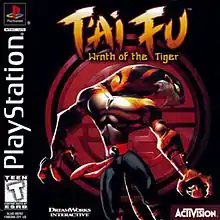T'ai Fu: Wrath of the Tiger
T'ai Fu: Wrath of the Tiger is a PlayStation game released in 1999, developed by DreamWorks Interactive (who would later be named EA Los Angeles, and finally Danger Close Games) and published by Activision. The game is set in an oriental landscape populated by clans of animals, such as Leopards and Snakes. The game's protagonist, T'ai Fu, is the last remaining survivor of the Tiger clan and must journey to defeat the Dragon Master and avenge his kind. On the way, he learns about his clouded past and masters several Kung Fu styles, one from each clan master he defeats.
| T'ai Fu: Wrath of the Tiger | |
|---|---|
 | |
| Developer(s) | DreamWorks Interactive |
| Publisher(s) | Activision |
| Composer(s) | Michael Giacchino |
| Platform(s) | PlayStation |
| Release | |
| Genre(s) | Action |
| Mode(s) | Single-player |
| Aggregator | Score |
|---|---|
| GameRankings | 68%(15 reviews)[1] |
| Publication | Score |
|---|---|
| AllGame | |
| CVG | |
| EGM | 5.5/10[lower-alpha 1] |
| GameFan | 72/100[lower-alpha 2] |
| GamePro | 3.125/5[lower-alpha 3] |
| GameRevolution | D[7] |
| GameSpot | 6/10[8] |
| Hyper | 89/100[9] |
| IGN | 7.5/10[10] |
| OPM (AU) | 7/10[11] |
| OPM (UK) | 5/10[12] |
| OPM (US) | |
| Play | 72%[14] |
| PSM |
Gameplay
While the game has some fairly challenging platformer aspects, the main focus of the gameplay is on fighting aggressors from other clans as T'ai seeks to receive Kung Fu tutoring from the masters of the clans. Each new style T'ai learns increases his repertoire of moves, and he can even learn more exotic moves such as energy blasts and the power of flight. An emphasis on combos is placed in the fighting, as each new style can be chained to one another in any order, allowing for impressively long and complex chains. The game also rewards players for completing combos, as pressing a specific button at the end of each combo refills a bit of the player's health and 'chi' energy (the latter which is used in performing energy blasts). Another unique aspect of the fighting aspect in the game, is that each move learned is not mutually exclusive to combat or platforming; they can be used for both to great effect.
Development
The soundtrack was composed by Michael Giacchino.
Notes
- Four critics from Electronic Gaming Monthly awarded T'ai Fu: Wrath of the Tiger different ratings: 6/10, 4/10, 6.5/10, and 5.5/10.[4]
- Four critics from GameFan scored T'ai Fu: Wrath of the Tiger differently: 68/100, 60/100, 70/100, and 90/100[5]
- T'ai Fu: Wrath of the Tiger was rated by GamePro 3.5/5 for graphics, 4/5 for sound, 2/5 for control, and 3/5 for play control.[6]
References
- "T'ai Fu: Wrath of the Tiger Review Score".
- Sackenheim, Shawn. "T'ai Fu: Wrath of the Tiger". AllGame. Archived from the original on November 14, 2014. Retrieved October 7, 2020.
- Lomas, Ed (May 1999). "Tai Fu". Computer and Video Games. No. 210. p. 54.
- Davison, John; Hsu, Dan; Smith, Shawn; Hagerr, Dean (April 1999). "T'ai Fu". Electronic Gaming Monthly. Vol. 12 no. 4. p. 127.
- Eggo; Teeter; Fury; ECM (April 1999). "T'ai Fu". GameFan. Vol. 7 no. 4. pp. 14, 52–53.
- Fatt, Boba (May 1999). "T'ai Fu: Wrath of the Tiger". GamePro. No. 128. p. 80.
- Liu, Johnny. "T'ai Foolish". GameRevolution. Archived from the original on June 6, 2004. Retrieved October 7, 2020.
- Taruc, Nelson (April 19, 1999). "T'ai Fu: Wrath of the Tiger Review". GameSpot. Retrieved October 7, 2020.
- Roff, Adam (July 1999). "Tai Fu: Wrath of the Tiger". Hyper. No. 69. pp. 54–55.
- Perry, Doug (April 5, 1999). "T'ai Fu: Wrath of the Tiger". IGN. Retrieved October 7, 2020.
- Lesslie, Hillous (March 1999). "T'ai Fu". Official Australian PlayStation Magazine. No. 20. p. 67.
- Price, James (May 1999). "T'ai Fu: Wrath of the Tiger". Official UK PlayStation Magazine. No. 45. pp. 104–105.
- Maruyama, Wataru (April 1999). "T'ai Fu". Official U.S. PlayStation Magazine. Vol. 2 no. 7. p. 91.
- "T'ai Fu". Play. No. 47. April 1999. pp. 58–59.
- "T'ai Fu". PlayStation Magazine. No. 20. April 1999. p. 36.
External links
- T'ai Fu: Wrath of the Tiger at MobyGames
- T'ai Fu: Wrath of a Tiger can be played for free in the browser on the Internet Archive